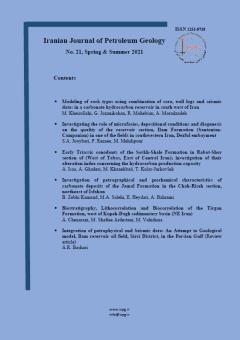-
-
List of Articles
-
Open Access Article
1 - 3D modeling of rock types using the integration of core, well logs and seismic data in one of the carbonate reservoirs of southwestern Iran.
Mahdi Kheirollahi Golnaz Jozanikohan Reza Mohebian Ali Moradzadeh -
Open Access Article
2 - Investigating the role of microfacies, depositional conditions and diagenesis on the quality of the reservoir section, Ilam Formation (Santonian-Campanian) in one of the fields in southwestern Iran, Dezful embayment
Seyedeh Akram Jooybari Peyman Rezaei Majid Mehdipour -
Open Access Article
3 - Early Triassic conodonts of the Sorkh-Shale Formation in Rabat-Shor section of (West of Tabas, East of Central Iran); investigation of their alteration index concerning the hydrocarbon production capacity
Abeer Issa Abbas Ghaderi Mohammad Khanehbad Tea Kolar-Jurkovšek -
Open Access Article
4 - Investigation of petrographical and geochemical characteristics of carbonate deposits of the Jamal Formation in the Chah-Riseh section, northeast of Isfahan
Behrad Zebhi Kamand محمد علی صالحی Ezat Heydari Ali Bahrami -
Open Access Article
5 - Biocorrelation, Biostratigraphy and determination basal of the Aptian stage at Tirgan Formation , west of Kopeh-Dagh sedimentary basin, NE Iran
Atefeh Chenarani Meysam Shafiee Ardestani Mohammad Vahidinia -
Open Access Article
6 - Integration of petrophysical and Seismic data: an Attempt to Geological model, Ilam reservoir oil field, Sirri District , in the Persian Gulf.
Alireza Bashari
-
The rights to this website are owned by the Raimag Press Management System.
Copyright © 2017-2026







